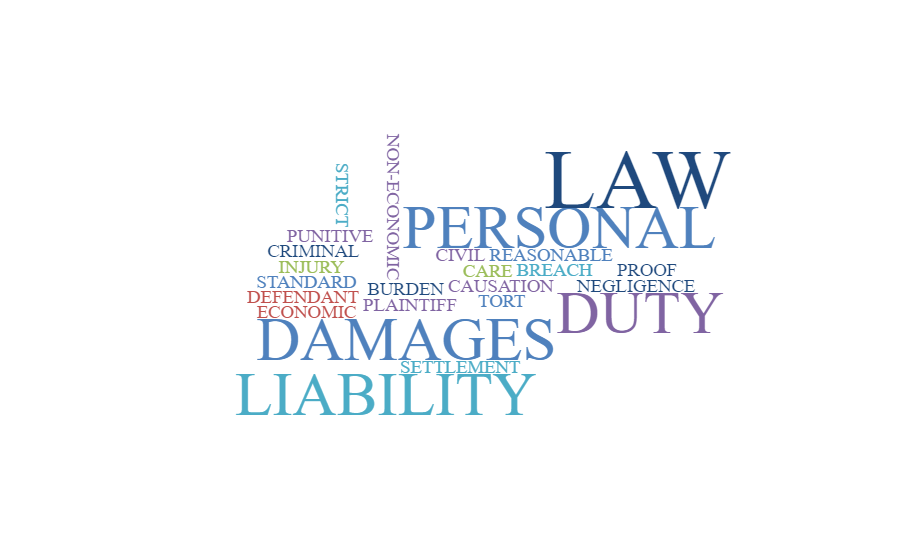
At some point in your life, you may have been introduced to the complex language of the legal field, whether by watching an exciting crime show, talking to a friend who was involved in a court case, or even while on jury duty.
A comprehensive glossary of terms used in the practice of Personal Injury Law would be quite long. Our latest blog will introduce you to key terms you are likely to hear when you have been injured and are seeking legal help, especially if your lawyer is recommending filing a lawsuit.
Here are a few useful personal injury law terms you might encounter.
Settlement
A settlement is a legally binding agreement between parties to a dispute that avoids the necessity of going to trial. Approximately 95% of personal injury cases are settled out of court. Generally, a settlement can take care of your major expenses related to the accident and some of the intangible losses you suffered, which are known as “general damages”. Statistically, injured people receive higher compensation in pre-trial settlements than is typical for cases that go to trial, owing to the great expense of trying a case. Hiring an experienced personal injury attorney can be the right decision to ensure a maximum settlement recovery.
Personal Injury
A personal injury occurs when an individual suffers bodily injury and resulting emotional distress because of the negligence, recklessness, or other wrongful conduct of another. Personal injury law is one kind of tort law (see below). “Pain and suffering” and “loss of enjoyment of life” at the hands of someone else are included as separate items of recoverable damages under New Mexico personal injury laws.
Economic and Non-Economic Damages
Economic Damages refer to verifiable monetary losses, such as medical expenses and lost wages. Non-economic damages refer to losses such as the loss of companionship or society of a loved one, pain and suffering, lost earning capacity, and lost enjoyment of life.
Punitive Damages
Punitive Damages are awarded with the purpose of deterring intentional or reckless behaviors motivated by a “culpable mind state.” Drunk driving is a perfect example of a case in which it would be appropriate to recover punitive damages, since the responsible party engaged in behavior that put others at risk with an utter indifference to the consequences.
Civil Law vs. Criminal Law
Civil Law concerns disputes between individuals in which a “plaintiff” has had his or her rights violated by another and sustains damages as a result. Personal injury is a kind of civil law that can result in recovery of monetary awards.
Criminal Law cases are those brought against individuals for wrongs committed against the State or other governmental entity. Laws at the local, state, and federal levels define criminal activities and establish legal punishments for those convicted of crimes like assault and theft. The government brings charges against the defendant that may result in the imposition of fees, fines, restitution, probation and/or jail time.
Tort Liability
Tort Liability refers to responsibility for an action in which an individual known as the “tortfeasor” is held accountable for his or her negligent or reckless actions. The word Tort derives from a Latin word that means “harm” or “wrong”. The main job of a personal injury lawyer is to establish liability by gathering evidence of negligent conduct. An experienced lawyer has the skills to successfully build a case. A tort is a wrongful act that causes harm to someone else. Torts in the legal system are split up into many different sub-categories as there are so many kinds of injuries.
Strict Liability
Strict Liability refers to a situation in which the defendant did not intentionally cause harm, but their actions posed an obvious risk such as keeping a large mountain lion as a pet. Most people recognize that as abnormal and dangerous, i.e., you don’t need to actually intend harm, but someone ends up injured anyway.
Reasonable Person and Standard of Care
Lawyers need to refer to a standard of care to compare with the defendant’s conduct. In New Mexico, the typical standard of care in a negligence case is known as the exercise of “ordinary care.” Ordinary care is that degree of care which a reasonably prudent person would exercise under similar circumstances. Courts ascertain whether ordinary care was exercised by a defendant by referring to the Reasonable Person. This “person” is not an actual person but a profile of a hypothetical, reasonable and rational individual, who approaches a situation with an appropriate ability to size it up and take reasonable steps.
For example, a reasonable person would realize that that mountain lion kitten is going to become very big and eventually pose a risk to others and would take certain measures to prevent foreseeable harm. The Reasonable Person serves as a comparative standard for courts to assess liability.
Plantiff and Deffendant
In a personal injury case, the Plaintiff is the person or entity that files the lawsuit.
The person or entity being sued is called the Defendant.
The Four Elements of Negligence
Juries are instructed to compare the facts, testimony and evidence determining whether the following four elements were present:
- Duty of Care: The defendant had an obligation to the plaintiff. For example, your physician has a duty to provide the best of care available and to follow the most widely accepted standard of care. If a doctor, for example, confused your medical records with another person resulting in harm, the law recognizes a relationship between the two parties and therefore an obligation to provide reasonable care exists.
- Breach of Duty: The defendant owed you a duty of care that was breached. A store didn’t clean up a spill promptly in one of the aisles, causing a customer to fall and incur injury.
- Causation: Putting it all together, causation requires a plaintiff to show that the breach of duty was the cause of the plaintiff’s injury. This can be tricky. If you are rear-ended in an accident and are already experiencing chronic back pain, how do you establish that the pain is caused from the accident?
- Damages: Actual losses as a direct result of the party’s negligence.
Burden of Proof
In a civil case, it is the plaintiff’s responsibility to prove that they were injured by the defendant in order to recover damages. In civil court, the standard requires that liability must be proven by a preponderance of evidence, which means the greater weight of the evidence, or, 51%. For instance, the plaintiff proves a case by persuading a jury that the great weight of the evidence presented demonstrates that the defendant breached a duty of care and caused injuries or damages.
Sadly, there are many ways in which people interact and cause injury to each other. We are experienced in many areas of Personal Injury and have been in business fighting for the rights of New Mexicans for over sixty years. We are here for you! Please call for a free consultation: 505.982.5380


